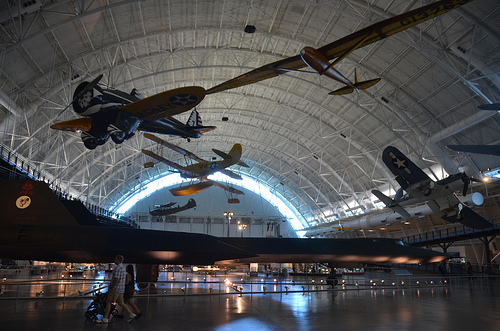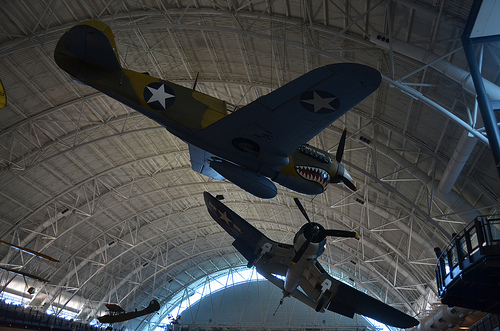Some cool inspection business china photos:
Steven F. Udvar-Hazy Center: Profile view of the SR-71 Blackbird, F-4 Corsair, Peashooter, among other people

Image by Chris Devers
Quoting Smithsonian National Air and Space Museum | Lockheed SR-71 Blackbird:
No reconnaissance aircraft in history has operated globally in much more hostile airspace or with such full impunity than the SR-71, the world’s fastest jet-propelled aircraft. The Blackbird’s efficiency and operational achievements placed it at the pinnacle of aviation technology developments for the duration of the Cold War.
This Blackbird accrued about two,800 hours of flight time for the duration of 24 years of active service with the U.S. Air Force. On its last flight, March six, 1990, Lt. Col. Ed Yielding and Lt. Col. Joseph Vida set a speed record by flying from Los Angeles to Washington, D.C., in 1 hour, four minutes, and 20 seconds, averaging 3,418 kilometers (two,124 miles) per hour. At the flight’s conclusion, they landed at Washington-Dulles International Airport and turned the airplane over to the Smithsonian.
Transferred from the United States Air Force.
Manufacturer:
Lockheed Aircraft Corporation
Designer:
Clarence L. "Kelly" Johnson
Date:
1964
Nation of Origin:
United States of America
Dimensions:
All round: 18ft five 15/16in. x 55ft 7in. x 107ft 5in., 169998.5lb. (5.638m x 16.942m x 32.741m, 77110.8kg)
Other: 18ft five 15/16in. x 107ft 5in. x 55ft 7in. (five.638m x 32.741m x 16.942m)
Components:
Titanium
Physical Description:
Twin-engine, two-seat, supersonic strategic reconnaissance aircraft airframe constructed largley of titanium and its alloys vertical tail fins are constructed of a composite (laminated plastic-sort material) to decrease radar cross-section Pratt and Whitney J58 (JT11D-20B) turbojet engines function huge inlet shock cones.
• • • • •
Quoting Smithsonian National Air and Space Museum | Boeing P-26A Peashooter :
The Boeing P-26A of the mid-to-late 1930s introduced the concept of the higher-overall performance, all-metal monoplane fighter design and style, which would grow to be common during World War II. A radical departure from wood-and-fabric biplanes, the Peashooter nonetheless retained an open cockpit, fixed landing gear, and external wing bracing.
Most P-26As stationed overseas were ultimately sold to the Philippines or assigned to the Panama Canal Division Air Force, a branch of the U.S. Army Air Corps. A number of went to China and one particular to Spain. This one particular was based at Selfridge Field in Michigan and Fairfield Air Depot in Ohio between its acceptance by the U.S. Army Air Corps in 1934 and its transfer to the Canal Zone in 1938. It was offered to Guatemala in 1942 and flew in the Guatemalan air force until 1954. Guatemala donated it to the Smithsonian in 1957.
Gift of the Guatemalan Air Force, Republic of Guatemala
Manufacturer:
Boeing Aircraft Co.
Date:
1934
Nation of Origin:
United States of America
Dimensions:
Wingspan: eight.five m (27 ft 11 in)
Length:7.3 m (23 ft 11 in)
Height:three.1 m (ten ft 2 in)
Weight, empty:996 kg (two,196 lb)
Weight, gross:1,334 kg (two,935 lb)
Top speed:377 km/h (234 mph)
Engine:Pratt & Whitney R-1340-27, 600 hp
Armament:two .30 cal. M2 Browning aircraft machine guns
• • • • •
Quoting Smithsonian National Air and Space Museum | Vought F4U-1D Corsair :
By V-J Day, September two, 1945, Corsair pilots had amassed an 11:1 kill ratio against enemy aircraft. The aircraft’s distinctive inverted gull-wing design allowed ground clearance for the massive, three-bladed Hamilton Regular Hydromatic propeller, which spanned a lot more than four meters (13 feet). The Pratt and Whitney R-2800 radial engine and Hydromatic propeller was the biggest and one particular of the most powerful engine-propeller combinations ever flown on a fighter aircraft.
Charles Lindbergh flew bombing missions in a Corsair with Marine Air Group 31 against Japanese strongholds in the Pacific in 1944. This airplane is painted in the colors and markings of the Corsair Sun Setter, a Marine close-assistance fighter assigned to the USS Essex in July 1944.
Transferred from the United States Navy.
Manufacturer:
Vought Aircraft Firm
Date:
1940
Nation of Origin:
United States of America
Dimensions:
Overall: 460 x 1020cm, 4037kg, 1250cm (15ft 1 1/8in. x 33ft five 9/16in., 8900lb., 41ft 1/8in.)
Components:
All metal with fabric-covered wings behind the principal spar.
Physical Description:
R-2800 radial air-cooled engine with 1,850 horsepower, turned a 3-blade Hamilton Standard Hydromatic propeller with solid aluminum blades spanning 13 feet 1 inch wing bent gull-shaped on both sides of the fuselage.
Steven F. Udvar-Hazy Center: F-four Corsair & P-40 Warhawk

Image by Chris Devers
Quoting Smithsonian National Air and Space Museum | Curtiss P-40E Warhawk (Kittyhawk IA):
Whether recognized as the Warhawk, Tomahawk, or Kittyhawk, the Curtiss P-40 proved to be a profitable, versatile fighter in the course of the initial half of Globe War II. The shark-mouthed Tomahawks that Gen. Claire Chennault’s "Flying Tigers" flew in China against the Japanese stay amongst the most popular airplanes of the war. P-40E pilot Lt. Boyd D. Wagner became the 1st American ace of World War II when he shot down six Japanese aircraft in the Philippines in mid-December 1941.
Curtiss-Wright built this airplane as Model 87-A3 and delivered it to Canada as a Kittyhawk I in 1941. It served till 1946 in No. 111 Squadron, Royal Canadian Air Force. U.S. Air Force personnel at Andrews Air Force Base restored it in 1975 to represent an aircraft of the 75th Fighter Squadron, 23rd Fighter Group, 14th Air Force.
Donated by the Exchange Club in Memory of Kellis Forbes.
Manufacturer:
Curtiss Aircraft Firm
Date:
1939
Nation of Origin:
United States of America
Dimensions:
Overall: 330 x 970cm, 2686kg, 1140cm (10ft 9 15/16in. x 31ft 9 7/8in., 5921.6lb., 37ft 4 13/16in.)
Components:
All-metal, semi-monocoque
Physical Description:
Single engine, single seat, fighter aircraft.
• • • • •
Quoting Smithsonian National Air and Space Museum | Vought F4U-1D Corsair:
By V-J Day, September two, 1945, Corsair pilots had amassed an 11:1 kill ratio against enemy aircraft. The aircraft’s distinctive inverted gull-wing design and style permitted ground clearance for the huge, three-bladed Hamilton Regular Hydromatic propeller, which spanned more than four meters (13 feet). The Pratt and Whitney R-2800 radial engine and Hydromatic propeller was the largest and one particular of the most potent engine-propeller combinations ever flown on a fighter aircraft.
Charles Lindbergh flew bombing missions in a Corsair with Marine Air Group 31 against Japanese strongholds in the Pacific in 1944. This airplane is painted in the colors and markings of the Corsair Sun Setter, a Marine close-support fighter assigned to the USS Essex in July 1944.
Transferred from the United States Navy.
Manufacturer:
Vought Aircraft Company
Date:
1940
Country of Origin:
United States of America
Dimensions:
Overall: 460 x 1020cm, 4037kg, 1250cm (15ft 1 1/8in. x 33ft five 9/16in., 8900lb., 41ft 1/8in.)
Components:
All metal with fabric-covered wings behind the main spar.
Physical Description:
R-2800 radial air-cooled engine with 1,850 horsepower, turned a three-blade Hamilton Common Hydromatic propeller with strong aluminum blades spanning 13 feet 1 inch wing bent gull-shaped on each sides of the fuselage.